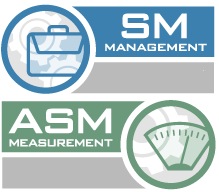SM/ASM 2000 - Software Management & Applications of Software Measurement

PRESENTATIONS
|
Software Measurement Programs: What Does It Take to Succeed?
A great deal is known about technical issues of data gathering and applied statistics as it relates to software measurement and analysis. However, less is known about what it takes to implement a successful software measurement program. In this presentation, Dennis Goldenson shares the results of a broad-based survey of practitioners and users of software measurement programs, providing better insight into what it takes to establish an effective software measurement program in your organization. |
|
|
Software Measurement--What's in it for Me?
This presentation looks at the success or failure of software measurement programs from a unique perspective: It addresses the human problems often encountered during implementation. Learn about the areas of resistance to measurement programs and how to use practical strategies when combating this resistance. Discover tactics that management can use to motivate software developers to make these programs work! |
|
|
The Devil's in the Details: IT Benchmarking--Aligning Outsourcing Expectations and Managing Risks
Gathering IT intelligence data is critical to deciding what and when to outsource, and how to structure service levels to create a winning deal for both sides. Based on IT benchmark trends observed from a modern database of 5,000+ completed projects gathered worldwide, learn how to identify proposals that satisfactorily address application development and maintenance productivity from a multi-dimensional perspective. |

Michael Mah, QSM Associates, Inc. |
|
The Problem of Project Management
As a project manager, your daily work is an unending stream of challenges. The burden of project success often lies at your feet. Brian Lawrence contends that one reason so many software projects fail is because project managers may be trying to solve the wrong problems. Learn how to use problem definition as a way to establish a standard against which you can compare yourself to evaluate your performance. |
|
|
Third-Party Testing and Its Effects on Software Engineering
Adherence to process guidelines has been shown to be beneficial for large organizations. However, ninety-nine percent of all U.S. IT organizations and independent software vendors are small businesses with less than 500 employees. Bill Councill discusses how to use a third-party testing organization such as Underwriters Laboratories to more effectively assure software quality in companies of this size. |
|
|
Tips from the Training Tsarina
This presentation explores ways to plan and execute technical training to ensure the best possible use of resources to meet your organization's objectives. Learn how to avoid the most common problems and shortfalls, including budget woes, business relevance, and lack of commitment. Discover the most effective ways to breathe life into your organization's training program. |
|
|
Usability and Risk Management in a Multi-Developer Context
Driving usability improvement in an organization with more than 100 different software suppliers presents specific Quality Assurance challenges. This presentation describes the steps taken by one organization to meet this challenge. Learn how this approach resulted in a one hundred percent increase in customer satisfaction, a reduction in customer-reported usability problems, and order-of-magnitude reductions in testing time and cost. |
|
|
User Errors Are Not Software Bugs
Traditional practices of user feedback are inefficient because they do not incorporate vital information about user errors. Typically, uers report on unexpected system behavior associated with their intentions, instead of their actions, resulting in software developers wasting their time chasing phantom bugs. Learn how to distinguish real bugs from user errors by using an operation logger integrated within your software product. |
|
|
Using Metrics to Govern Outsourced Applications
Outsourcing arrangements are established on the basis of a contractual partnership, with both parties having a vested interest in the success of the relationship. Success can be viewed differently by the outsourcing provider and customer, however, making the use of objective, quantifying service level metrics instrumental to the success of the contract. Learn how to properly identify and develop service level metrics required to support both business and technical deliverables. |
|
|
Using Software Measurement to Effect Change
Using a real-life case study, Jeanette Horan presents how the search for product quality improvement at Lotus led to the realization that the software measurement process needed to be changed to drive organizational priorities. Learn how a cross-functional team provided recommendations for a new process, standardized on core metrics, and implemented a new self-service application. |
|


